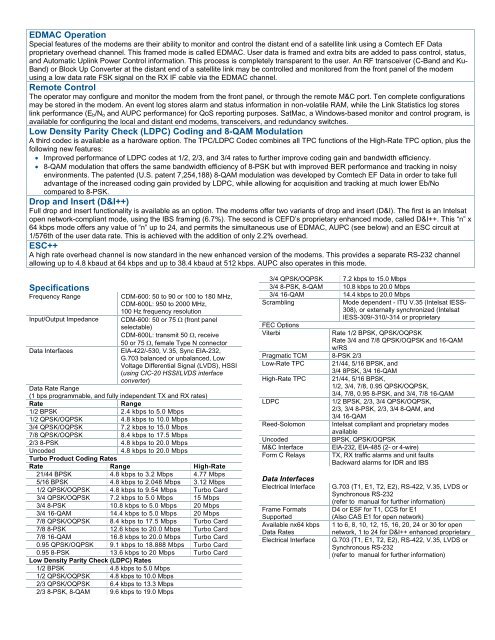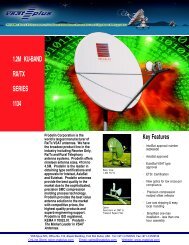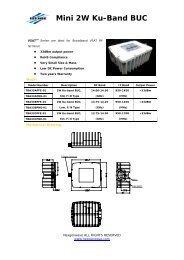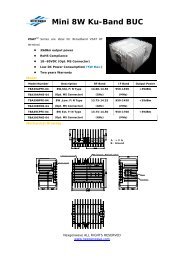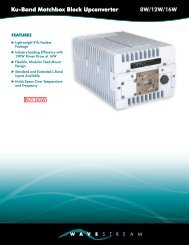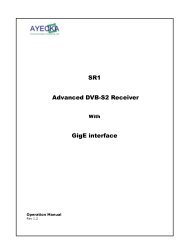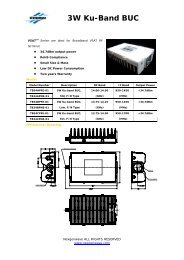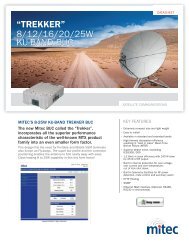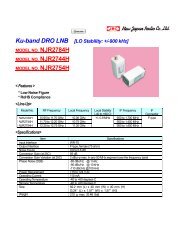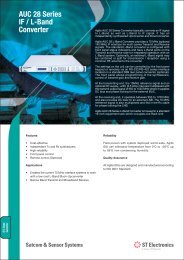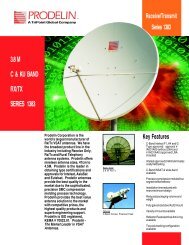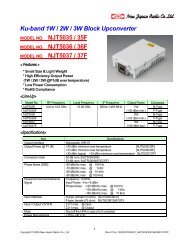CDM-600 & CDM-600L Open Network Satellite Modems Satellite Modems
Comtech CDM-600 & CDM-600L Open Network Satellite Modems ...
Comtech CDM-600 & CDM-600L Open Network Satellite Modems ...
- No tags were found...
Create successful ePaper yourself
Turn your PDF publications into a flip-book with our unique Google optimized e-Paper software.
EDMAC Operation<br />
Special features of the modems are their ability to monitor and control the distant end of a satellite link using a Comtech EF Data<br />
proprietary overhead channel. This framed mode is called EDMAC. User data is framed and extra bits are added to pass control, status,<br />
and Automatic Uplink Power Control information. This process is completely transparent to the user. An RF transceiver (C-Band and Ku-<br />
Band) or Block Up Converter at the distant end of a satellite link may be controlled and monitored from the front panel of the modem<br />
using a low data rate FSK signal on the RX IF cable via the EDMAC channel.<br />
Remote Control<br />
The operator may configure and monitor the modem from the front panel, or through the remote M&C port. Ten complete configurations<br />
may be stored in the modem. An event log stores alarm and status information in non-volatile RAM, while the Link Statistics log stores<br />
link performance (E b /N o and AUPC performance) for QoS reporting purposes. SatMac, a Windows-based monitor and control program, is<br />
available for configuring the local and distant end modems, transceivers, and redundancy switches.<br />
Low Density Parity Check (LDPC) Coding and 8-QAM Modulation<br />
A third codec is available as a hardware option. The TPC/LDPC Codec combines all TPC functions of the High-Rate TPC option, plus the<br />
following new features:<br />
Improved performance of LDPC codes at 1/2, 2/3, and 3/4 rates to further improve coding gain and bandwidth efficiency.<br />
8-QAM modulation that offers the same bandwidth efficiency of 8-PSK but with improved BER performance and tracking in noisy<br />
environments. The patented (U.S. patent 7,254,188) 8-QAM modulation was developed by Comtech EF Data in order to take full<br />
advantage of the increased coding gain provided by LDPC, while allowing for acquisition and tracking at much lower Eb/No<br />
compared to 8-PSK.<br />
Drop and Insert (D&I++)<br />
Full drop and insert functionality is available as an option. The modems offer two variants of drop and insert (D&I). The first is an Intelsat<br />
open network-compliant mode, using the IBS framing (6.7%). The second is CEFD’s proprietary enhanced mode, called D&I++. This “n” x<br />
64 kbps mode offers any value of “n” up to 24, and permits the simultaneous use of EDMAC, AUPC (see below) and an ESC circuit at<br />
1/576th of the user data rate. This is achieved with the addition of only 2.2% overhead.<br />
ESC++<br />
A high rate overhead channel is now standard in the new enhanced version of the modems. This provides a separate RS-232 channel<br />
allowing up to 4.8 kbaud at 64 kbps and up to 38.4 kbaud at 512 kbps. AUPC also operates in this mode.<br />
Specifications<br />
Frequency Range<br />
<strong>CDM</strong>-<strong>600</strong>: 50 to 90 or 100 to 180 MHz,<br />
<strong>CDM</strong>-<strong>600</strong>L: 950 to 2000 MHz,<br />
100 Hz frequency resolution<br />
Input/Output Impedance <strong>CDM</strong>-<strong>600</strong>: 50 or 75 (front panel<br />
selectable)<br />
<strong>CDM</strong>-<strong>600</strong>L: transmit 50 , receive<br />
50 or 75 , female Type N connector<br />
Data Interfaces<br />
EIA-422/-530, V.35, Sync EIA-232,<br />
G.703 balanced or unbalanced, Low<br />
Voltage Differential Signal (LVDS), HSSI<br />
(using CIC-20 HSSI/LVDS interface<br />
converter)<br />
Data Rate Range<br />
(1 bps programmable, and fully independent TX and RX rates)<br />
Rate<br />
Range<br />
1/2 BPSK 2.4 kbps to 5.0 Mbps<br />
1/2 QPSK/OQPSK 4.8 kbps to 10.0 Mbps<br />
3/4 QPSK/OQPSK 7.2 kbps to 15.0 Mbps<br />
7/8 QPSK/OQPSK 8.4 kbps to 17.5 Mbps<br />
2/3 8-PSK 4.8 kbps to 20.0 Mbps<br />
Uncoded<br />
4.8 kbps to 20.0 Mbps<br />
Turbo Product Coding Rates<br />
Rate Range High-Rate<br />
21/44 BPSK 4.8 kbps to 3.2 Mbps 4.77 Mbps<br />
5/16 BPSK 4.8 kbps to 2.048 Mbps 3.12 Mbps<br />
1/2 QPSK/OQPSK 4.8 kbps to 9.54 Mbps Turbo Card<br />
3/4 QPSK/OQPSK 7.2 kbps to 5.0 Mbps 15 Mbps<br />
3/4 8-PSK 10.8 kbps to 5.0 Mbps 20 Mbps<br />
3/4 16-QAM 14.4 kbps to 5.0 Mbps 20 Mbps<br />
7/8 QPSK/OQPSK 8.4 kbps to 17.5 Mbps Turbo Card<br />
7/8 8-PSK 12.6 kbps to 20.0 Mbps Turbo Card<br />
7/8 16-QAM 16.8 kbps to 20.0 Mbps Turbo Card<br />
0.95 QPSK/OQPSK 9.1 kbps to 18.888 Mbps Turbo Card<br />
0.95 8-PSK 13.6 kbps to 20 Mbps Turbo Card<br />
Low Density Parity Check (LDPC) Rates<br />
1/2 BPSK 4.8 kbps to 5.0 Mbps<br />
1/2 QPSK/OQPSK 4.8 kbps to 10.0 Mbps<br />
2/3 QPSK/OQPSK 6.4 kbps to 13.3 Mbps<br />
2/3 8-PSK, 8-QAM 9.6 kbps to 19.0 Mbps<br />
3/4 QPSK/OQPSK 7.2 kbps to 15.0 Mbps<br />
3/4 8-PSK, 8-QAM 10.8 kbps to 20.0 Mbps<br />
3/4 16-QAM 14.4 kbps to 20.0 Mbps<br />
Scrambling<br />
FEC Options<br />
Viterbi<br />
Mode dependent - ITU V.35 (Intelsat IESS-<br />
308), or externally synchronized (Intelsat<br />
IESS-309/-310/-314 or proprietary<br />
Rate 1/2 BPSK, QPSK/OQPSK<br />
Rate 3/4 and 7/8 QPSK/OQPSK and 16-QAM<br />
w/RS<br />
Pragmatic TCM 8-PSK 2/3<br />
Low-Rate TPC 21/44, 5/16 BPSK, and<br />
3/4 8PSK, 3/4 16-QAM<br />
High-Rate TPC<br />
LDPC<br />
Reed-Solomon<br />
Uncoded<br />
M&C Interface<br />
Form C Relays<br />
Data Interfaces<br />
Electrical Interface<br />
Frame Formats<br />
Supported<br />
Available nx64 kbps<br />
Data Rates<br />
Electrical Interface<br />
21/44, 5/16 BPSK,<br />
1/2, 3/4, 7/8, 0.95 QPSK/OQPSK,<br />
3/4, 7/8, 0.95 8-PSK, and 3/4, 7/8 16-QAM<br />
1/2 BPSK, 2/3, 3/4 QPSK/OQPSK,<br />
2/3, 3/4 8-PSK, 2/3, 3/4 8-QAM, and<br />
3/4 16-QAM<br />
Intelsat compliant and proprietary modes<br />
available<br />
BPSK, QPSK/OQPSK<br />
EIA-232, EIA-485 (2- or 4-wire)<br />
TX, RX traffic alarms and unit faults<br />
Backward alarms for IDR and IBS<br />
G.703 (T1, E1, T2, E2), RS-422, V.35, LVDS or<br />
Synchronous RS-232<br />
(refer to manual for further information)<br />
D4 or ESF for T1, CCS for E1<br />
(Also CAS E1 for open network)<br />
1 to 6, 8, 10, 12, 15, 16, 20, 24 or 30 for open<br />
network, 1 to 24 for D&I++ enhanced proprietary<br />
G.703 (T1, E1, T2, E2), RS-422, V.35, LVDS or<br />
Synchronous RS-232<br />
(refer to manual for further information)


